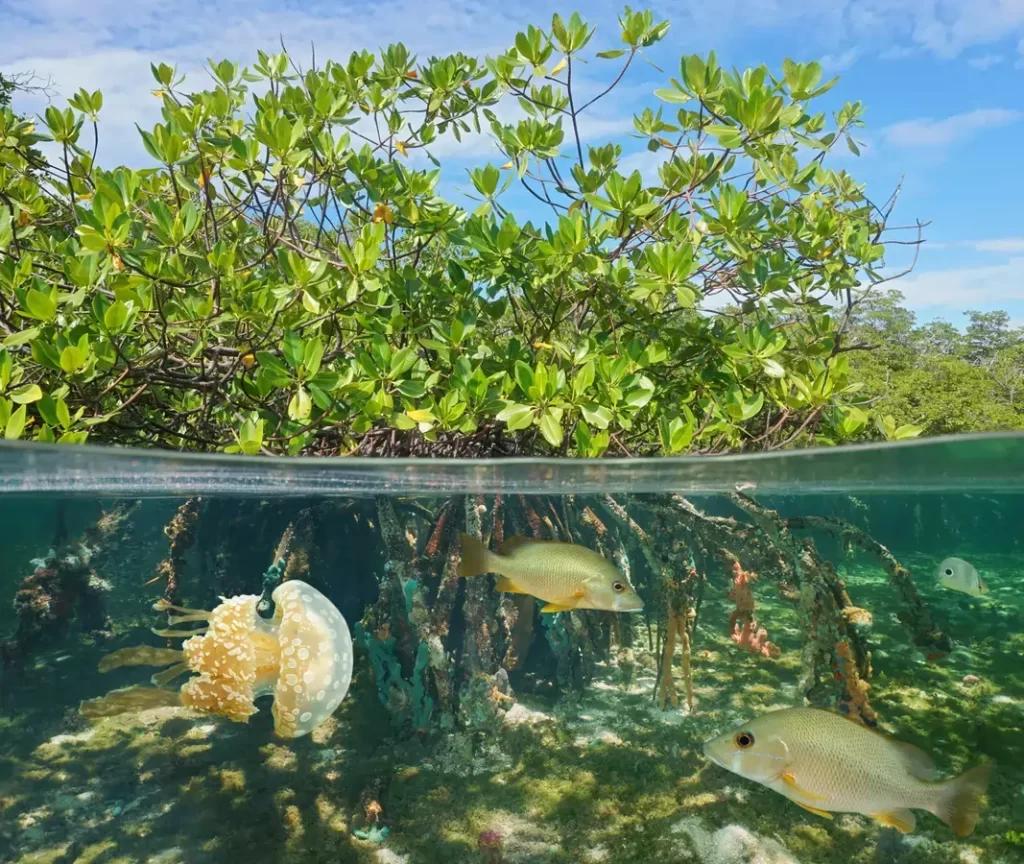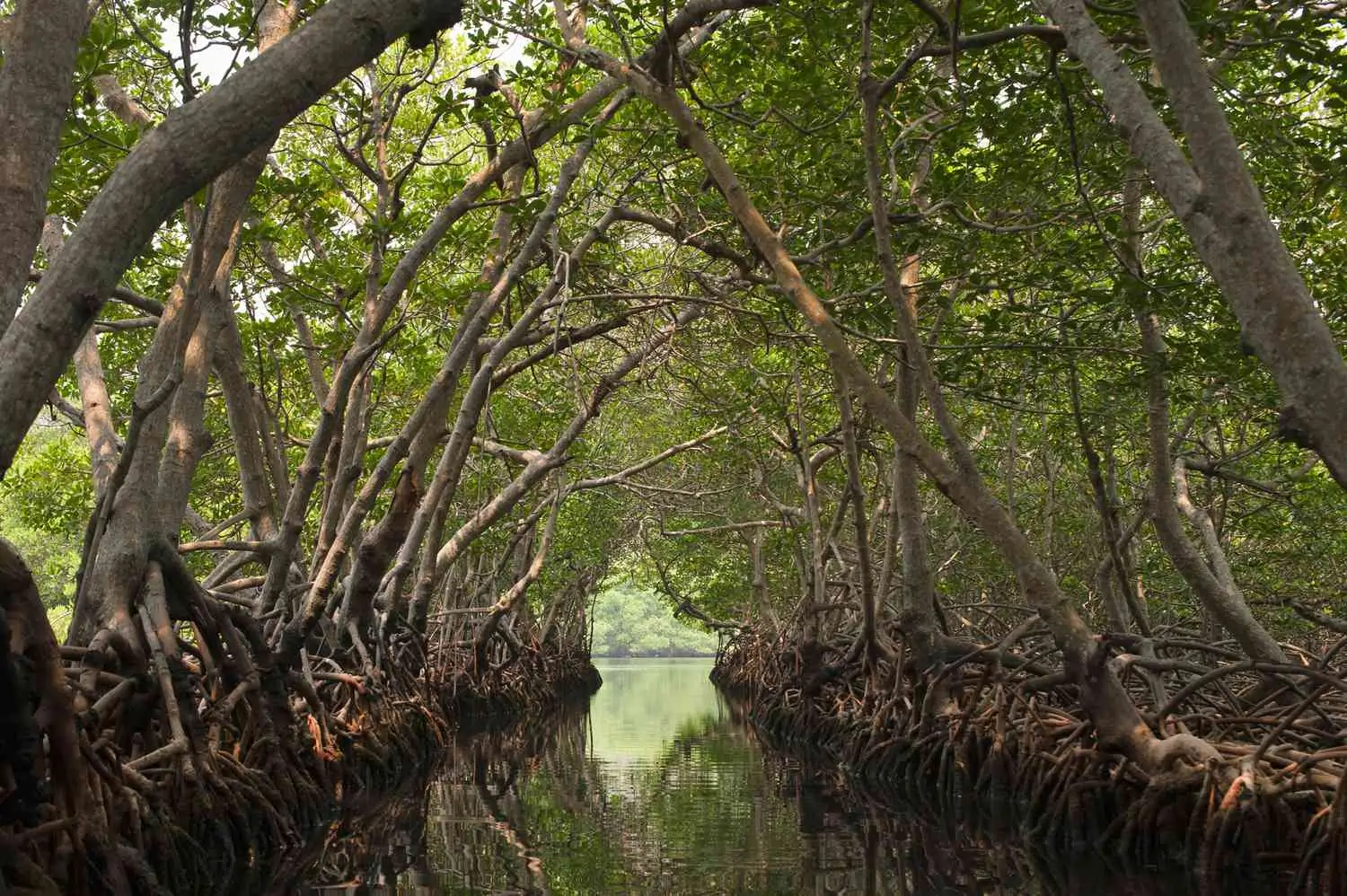Mangroves are essential for the Philippines’ survival. These coastal ecosystems protect communities, support marine life, and combat climate change
Mangrove Forest Ecosystems in the Philippines
Mangrove Forest are vital coastal ecosystems that form in tropical and subtropical regions where saltwater and freshwater converge. In the Philippines, mangrove forest an archipelago with extensive coastlines, mangroves play a crucial role in maintaining ecological balance and supporting the livelihoods of coastal communities. Mangrove forest are characterized by a variety of specialized tree and shrub species that possess adaptations such as salt- excreting leaves and complex root systems.
These adaptations enable them to thrive in environments where few other plants can survive. The roots of mangrove stabilize sediments, reducing coastal erosion and protecting the shoreline from the impact of waves and storm surges. This natural barrier is particularly important in a country like the Philippines, which is frequently affected by typhoons and other extreme weather events.

Distribution and Diversity
The Philippines is home to a rich diversity of mangrove forest species, with around 40 different species recorded. These are found along the coastlines, particularly in regions with brackish waters, such as Palawan, the Sulu Archipelago, and various parts of Mindanao and Luzon. Among the notable species are the mangrove apple (Sonneratia alba), known for its large, white flowers and edible fruit; the mangrove fern (Acrostichum aureum), one of the few ferns that can tolerate saline conditions; and the red mangrove (Rhizophora stylosa), recognizable by its distinctive stilt roots that provide stability in soft, waterlogged soils.
Mangrove forest are not uniformly distributed across the country; their presence and health are influenced by factors such as water salinity, tidal patterns, and human activities. For instance, the province of Palawan boasts some of the most pristine and extensive mangrove forests due to its relatively low population density and less industrial development. In contrast, regions with higher levels of coastal development and aquaculture, such as parts of Luzon, face greater challenges in mangrove conservation.
Case Study: Sultan Kudarat
In Sultan Kudarat, a province located in the southern part of Mindanao, mangrove ecosystems are particularly noteworthy for their diversity and ecological importance. Studies conducted in the coastal municipalities of Kalamansig, Lebak, and Palimbang have identified a total of 31 mangrove species. The diversity in these areas is high, with Kalamansig hosting 24 species, Lebak 30 species, and Palimbang 20 species. These species belong to 15 genera and 14 families, with the family Rhizophoraceae being especially dominant. This diversity is significant, considering that the total number of mangrove species in the Philippines is around 40.
Among the species found in Sultan Kudarat are three that are classified a s threatened: Ceriops zippeliana, Avicennia rumphiana, and Camptostemon philippinensis. The presence of these species indicates the ecological importance of the region and highlights the urgent need for conservation efforts. Despite the awareness among local communities about the importance of mangroves, challenges such as unregulated aquaculture and other anthropogenic pressures continue to threaten these ecosystems. The conservation and management strategies in Sultan Kudarat, therefore, need to be enhanced to protect these valuable natural resources.

Ecological Importance
The ecological importance of mangrove forest extends beyond their immediate environments. They serve as critical nursery grounds for numerous marine organisms, including fish, crustaceans, and mollusks. The complex root systems of mangrove trees offer shelter and protection for juvenile fish and other marine life, significantly contributing to the maintenance of marine biodiversity. Moreover, mangroves support terrestrial wildlife, including various bird species and small mammals. For example, mangrove areas are crucial habitats for the endangered Philippine crocodile (Crocodylus mindorensis) and provide nesting sites for numerous bird species, such as herons and kingfishers.
For instance, certain species of crabs and mollusks play a role in nutrient cycling by breaking down organic matter, thus supporting the overall health of the ecosystem. Another critical ecological function of mangroves is their role in climate regulation. Mangrove forests act as significant carbon sinks, sequestering carbon dioxide from the atmosphere and storing it in their biomass and sediments. This capacity for carbon storage helps mitigate the impacts of climate change. The cooling effect of mangrove canopies also contributes to the comfort and well-being of nearby communities.
Economic and Social Benefits
Mangroves offer substantial economic and social benefits to local communities. One of the most direct benefits is their support for fisheries. The health of these fisheries is thus directly linked to the health of mangrove ecosystems. In the Philippines, where fishing is a vital industry and source of livelihood, the preservation of mangroves is crucial for sustaining fish stocks and ensuring food security. The unique beauty and biodiversity of mangrove forests attract tourists interested in activities like bird watching, kayaking, and guided nature tours.
This tourism generates income and employment opportunities for local communities, promoting sustainable economic development. For example, in Palawan and other coastal areas, eco-tourism initiatives centered around mangroves have become important sources of revenue, helping to support conservation efforts and raise awareness about the importance of these ecosystems. Culturally, mangroves are integral to the identities of many coastal communities in the Philippines.
Traditional practices and knowledge related to the use and management of mangrove resources are passed down through generations. These practices often involve the sustainable harvesting of mangrove wood for construction, fuel, and traditional crafts. Additionally, various parts of mangrove trees are used in traditional medicine, valued for their antimicrobial, anti- inflammatory, and antioxidant properties.
The social benefits of mangroves also include their role in public health. By filtering pollutants and improving water quality, mangroves help reduce the exposure of local communities to harmful substances. The recreational opportunities provided by mangroves, such as nature walks and bird watching, contribute to physical and mental well-being. The presence of mangroves can enhance the aesthetic value of coastal landscapes, contributing to a community’s sense of place and identity.
Conservation and Threats
Despite their importance, mangroves face numerous threats from human activities. One of the most significant threats is deforestation, often driven by the conversion of mangrove areas into agricultural land, aquaculture ponds, or urban developments. In the Philippines, the expansion of aquaculture, particularly for shrimp farming, has led to significant losses of mangrove forests. This destruction not only reduces biodiversity but also increases the vulnerability of coastal areas to storm surges and erosion. Pollution is another major threat to mangrove ecosystems.
Runoff from agricultural and urban areas often carries pollutants, such as pesticides, heavy metals, and plastics, which can harm mangrove trees and the organisms that depend on them. Additionally, oil spills and other forms of industrial pollution can have devastating effects on mangrove habitats, leading to the death of trees and the degradation of the ecosystem.
Climate change poses a long-term threat to mangroves, as rising sea levels and changing temperature and precipitation patterns can alter the conditions in which mangroves thrive. While mangroves are naturally resilient and can adapt to some degree of change, the rapid pace of current climate change may outstrip their ability to adapt. This could result in the loss of mangrove areas, with consequent impacts on the biodiversity and communities they support.
Various conservation initiatives have been undertaken in the Philippines. The government, through agencies like the Department of Environment and Natural Resources (DENR), plays a leading role in mangrove conservation and restoration efforts. These initiatives include the establishment of marine protected areas (MPAs), where destructive activities like logging, dredging, and coastal development are restricted or prohibited. MPAs help safeguard critical mangrove habitats and provide a framework for sustainable management.
Community involvement is crucial for the success of conservation efforts. Local communities are often directly dependent on mangrove resources and have traditional knowledge about their sustainable use. Engaging communities in conservation activities, such as reforestation projects and monitoring of protected areas, can enhance the effectiveness of these initiatives. For instance, community-based organizations in the Philippines have successfully implemented mangrove planting projects, which not only restore degraded areas but also provide livelihood opportunities through eco-tourism and sustainable resource management.
Education and awareness programs are also essential components of conservation strategies. These programs aim to inform the public and stakeholders about the importance of mangroves and the threats they face. By raising awareness, these programs can foster a sense of stewardship and encourage more sustainable behaviors. For example, school-based programs and eco-tourism activities can educate both locals and visitors about the ecological and cultural value of mangrove forest, promoting a broader commitment to conservation.
Mangrove Products and Services
Mangroves provide a variety of products and services that are valuable both economically and environmentally. Mangrove wood, known for its density and resistance to water and pests, is used in construction, furniture making, and as fuel. Certain mangrove species, such as Rhizophora.
If you like this post, you may read this article:
- Inventory of mangroves in Katunggan Coastal Eco-Park, Sultan Kudarat Province, the Philippines
- Mangrove Flora in the Coastal Municipalities of Sultan Kudarat Province, Philippines
You may also read and explore: Civet Philippines, Unveiling the Word of Musang and Kopi luwak


